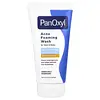What's inside
What's inside
 Key Ingredients
Key Ingredients

 Benefits
Benefits

 Concerns
Concerns

 Ingredients Side-by-side
Ingredients Side-by-side

Water
Skin ConditioningCocamidopropyl Betaine
CleansingSodium Lauroyl Sarcosinate
CleansingGlycerin
HumectantSodium Chloride
MaskingPEG-150 Pentaerythrityl Tetrastearate
EmulsifyingSalicylic Acid
MaskingSodium Benzoate
MaskingGluconolactone
Skin ConditioningNiacinamide
SmoothingTetrasodium Glutamate Diacetate
Citric Acid
BufferingSodium Lauroyl Lactylate
EmulsifyingSodium Hyaluronate Crosspolymer
HumectantSodium Hydroxide
BufferingCeramide NP
Skin ConditioningPhenoxyethanol
PreservativeCholesterol
EmollientCeramide AP
Skin ConditioningPhytosphingosine
Skin ConditioningPentylene Glycol
Skin ConditioningEthylhexylglycerin
Skin ConditioningXanthan Gum
EmulsifyingCarbomer
Emulsion StabilisingCeramide EOP
Skin ConditioningWater, Cocamidopropyl Betaine, Sodium Lauroyl Sarcosinate, Glycerin, Sodium Chloride, PEG-150 Pentaerythrityl Tetrastearate, Salicylic Acid, Sodium Benzoate, Gluconolactone, Niacinamide, Tetrasodium Glutamate Diacetate, Citric Acid, Sodium Lauroyl Lactylate, Sodium Hyaluronate Crosspolymer, Sodium Hydroxide, Ceramide NP, Phenoxyethanol, Cholesterol, Ceramide AP, Phytosphingosine, Pentylene Glycol, Ethylhexylglycerin, Xanthan Gum, Carbomer, Ceramide EOP
Benzoyl Peroxide 10%
Water
Skin ConditioningCarbomer
Emulsion StabilisingDecyl Glucoside
CleansingDimethicone
EmollientDiheptyl Sodium Sulfosuccinate
CleansingGlycerin
HumectantOleic Acid
EmollientPalmitic Acid
EmollientPolyacrylate Crosspolymer-6
Emulsion StabilisingPEG-40 Stearate
EmulsifyingPropanediol
SolventSilica
AbrasiveSodium Chloride
MaskingSodium Citrate
BufferingSodium Hydroxide
BufferingSodium Laurylglucosides Hydroxypropylsulfonate
CleansingSorbitan Stearate
EmulsifyingStearic Acid
CleansingXanthan Gum
EmulsifyingBenzoyl Peroxide 10%, Water, Carbomer, Decyl Glucoside, Dimethicone, Diheptyl Sodium Sulfosuccinate, Glycerin, Oleic Acid, Palmitic Acid, Polyacrylate Crosspolymer-6, PEG-40 Stearate, Propanediol, Silica, Sodium Chloride, Sodium Citrate, Sodium Hydroxide, Sodium Laurylglucosides Hydroxypropylsulfonate, Sorbitan Stearate, Stearic Acid, Xanthan Gum
 Reviews
Reviews

Ingredients Explained
These ingredients are found in both products.
Ingredients higher up in an ingredient list are typically present in a larger amount.
Carbomer is a polymer of acrylic acid. Its main role is to create a gel consistency.
A high amount of carbomer can cause pilling or balling up of products. Don't worry, most products contain 1% or less of carbomer.
Glycerin is already naturally found in your skin. It helps moisturize and protect your skin.
A study from 2016 found glycerin to be more effective as a humectant than AHAs and hyaluronic acid.
As a humectant, it helps the skin stay hydrated by pulling moisture to your skin. The low molecular weight of glycerin allows it to pull moisture into the deeper layers of your skin.
Hydrated skin improves your skin barrier; Your skin barrier helps protect against irritants and bacteria.
Glycerin has also been found to have antimicrobial and antiviral properties. Due to these properties, glycerin is often used in wound and burn treatments.
In cosmetics, glycerin is usually derived from plants such as soybean or palm. However, it can also be sourced from animals, such as tallow or animal fat.
This ingredient is organic, colorless, odorless, and non-toxic.
Glycerin is the name for this ingredient in American English. British English uses Glycerol/Glycerine.
Learn more about GlycerinChances are, you eat sodium chloride every day. Sodium Chloride is also known as table salt.
This ingredient has many purposes in skincare: thickener, emulsifier, and exfoliator.
You'll most likely find this ingredient in cleansers where it is used to create a gel-like texture. As an emulsifier, it also prevents ingredients from separating.
There is much debate on whether this ingredient is comedogenic. The short answer - comedogenic ratings don't tell the whole story. Learn more about comegodenic ratings here.
The concensus about this ingredient causing acne seems to be divided. Research is needed to understand if this ingredient does cause acne.
Scrubs may use salt as the primary exfoliating ingredient.
Learn more about Sodium ChlorideSodium Hydroxide is also known as lye or caustic soda. It is used to adjust the pH of products; many ingredients require a specific pH to be effective.
In small amounts, sodium hydroxide is considered safe to use. However, large amounts may cause chemical burns due to its high alkaline.
Your skin has a natural pH and acid mantle. This acid mantle helps prevent harmful bacteria from breaking through. The acid mantle also helps keep your skin hydrated.
"Alkaline" refers to a high pH level. A low pH level would be considered acidic.
Learn more about Sodium HydroxideWater. It's the most common cosmetic ingredient of all. You'll usually see it at the top of ingredient lists, meaning that it makes up the largest part of the product.
So why is it so popular? Water most often acts as a solvent - this means that it helps dissolve other ingredients into the formulation.
You'll also recognize water as that liquid we all need to stay alive. If you see this, drink a glass of water. Stay hydrated!
Learn more about WaterXanthan gum is used as a stabilizer and thickener within cosmetic products. It helps give products a sticky, thick feeling - preventing them from being too runny.
On the technical side of things, xanthan gum is a polysaccharide - a combination consisting of multiple sugar molecules bonded together.
Xanthan gum is a pretty common and great ingredient. It is a natural, non-toxic, non-irritating ingredient that is also commonly used in food products.
Learn more about Xanthan Gum